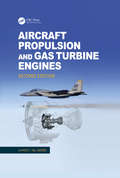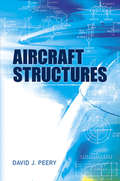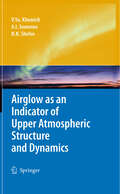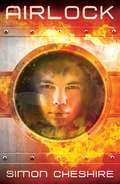- Table View
- List View
Airborne Occupational Hazards in Sewer Systems
by Amy Forsgren Kristina BrinckSewer systems fall into the category "out of sight, out of mind" – they seldom excite interest. But when things go wrong with the air in the sewer system, they go very wrong. Consequences can be dramatic and devastating: sewer workers killed instantly by poisonous gas when they lift a sewer lid, or entire suburban blocks levelled by explosions. This book describes the atmospheric dangers commonly found in the sewer system. It provides easily-understood explanations of the science behind the hazards, combined with real-life examples of when things went dramatically wrong.
Airborne Particulate Matter (The Handbook of Environmental Chemistry #4 / 4D)
by S. Biegalski I. Colbeck W. Holländer T. Kouimtzis P. Koutrakis S. Landsberger J. M. Pacyna S. N. Pandis C. Pilinis C. Samara E. Selin C. Sioutas A. I. ZouboulisAirborne particulate matter - especially aerosols, its origin, its impact on our environment, and its properties - has been of great scientific and public concern for many years. In this volume experts discuss in depth all relevant issues of airborne particulate matter, including the characterisation of aerosols by modern physical and chemical methods.
Airborne Particulate Matter: Source, Chemistry and Health
by Saurabh Sonwani Anuradha ShuklaThis book is about airborne particulate matter, sources, chemistry and health and contained a complete information about their emission source, transport, atmospheric chemistry, distribution at local, regional and global levels, and their level in indoor and outdoor settings. Primary and secondary particulate matters in the ambient atmosphere also describe in detail. Analytical techniques, statistical tools and mathematical models used in airborne particulate research is also described. This book also covers the important aspects of the particulate matter chemistry in atmosphere, and their adverse impact on plant and human health. A detailed insight about the harmful impact of airborne particulate matter (biogenic and anthropogenic both) on different human system is described in detail. The toxicological significance of particulate matter on human body was also mentioned. The mitigation, management and regulatory policies to control ambient particulate matter is also provided. This book is also written in simple language with helpful photographs, diagrams, tables and flowcharts which will make the reader comfortable in understanding the concepts a more relatively easier way. Overall, the present book is a valuable tool for students working in the fields of Atmospheric Science, Environmental Science, Biological Sciences, Epidemiology and Agriculture Science. This book also a unique resource for environmental consultants, researchers, policymakers and other professionals involved in air quality, plant and human health.
Airborne Wind Energy: An Overview of the Technological Approaches (Green Energy and Technology)
by Uwe AhrensThis book shows possible solutions to how a profitable energy supply can be implemented with almost no population resistance. Worldwide, more than 80 % of our energy needs are still covered by fossil fuels. Under these circumstances, can climate change still be stopped? Essential technologies for usage of wind energy with an emphasis on high-altitude wind utilization are presented. Airborne wind energy is one of the most promising technologies to enable a renewable energy turnaround in an economical way. The main problem of conventional renewable energy is the insufficient availability. To ensure a 100 % supply of renewable energy, enormous and very expensive storage capacities would have to be built up. How we can cover our entire energy needs (electricity, mobility and heat) in the future without fossil fuels, without risking the competitiveness of our economy, is shown in this book.
Airborne Wind Energy: Advances in Technology Development and Research (Green Energy and Technology)
by Roland SchmehlThis book provides in-depth coverage of the latest research and development activities concerning innovative wind energy technologies intended to replace fossil fuels on an economical basis. A characteristic feature of the various conversion concepts discussed is the use of tethered flying devices to substantially reduce the material consumption per installed unit and to access wind energy at higher altitudes, where the wind is more consistent.The introductory chapter describes the emergence and economic dimension of airborne wind energy. Focusing on “Fundamentals, Modeling & Simulation”, Part I includes six contributions that describe quasi-steady as well as dynamic models and simulations of airborne wind energy systems or individual components. Shifting the spotlight to “Control, Optimization & Flight State Measurement”, Part II combines one chapter on measurement techniques with five chapters on control of kite and ground stations, and two chapters on optimization. Part III on “Concept Design & Analysis” includes three chapters that present and analyze novel harvesting concepts as well as two chapters on system component design. Part IV, which centers on “Implemented Concepts”, presents five chapters on established system concepts and one chapter about a subsystem for automatic launching and landing of kites. In closing, Part V focuses with four chapters on “Technology Deployment” related to market and financing strategies, as well as on regulation and the environment.The book builds on the success of the first volume “Airborne Wind Energy” (Springer, 2013), and offers a self-contained reference guide for researchers, scientists, professionals and students. The respective chapters were contributed by a broad variety of authors: academics, practicing engineers and inventors, all of whom are experts in their respective fields.
Airbreathing Propulsion: An Introduction (Springer Aerospace Technology)
by Tarit BoseAirbreathing Propulsion covers the physics of combustion, fluid and thermo-dynamics, and structural mechanics of airbreathing engines, including piston, turboprop, turbojet, turbofan, and ramjet engines. End-of-chapter exercises allow the reader to practice the fundamental concepts behind airbreathing propulsion, and the included PAGIC computer code will help the reader to examine the relationships between the performance parameters of different engines. Large amounts of data have on many different piston, turbojet, and turboprop engines have been compiled for this book and are included as an appendix. This textbook is ideal for senior undergraduate and graduate students studying aeronautical engineering, aerospace engineering, and mechanical engineering.
Aircraft Fatigue Management (SpringerBriefs in Applied Sciences and Technology)
by Lorrie MolentFatigue occurs under cyclic loading and can significantly degrade the operational capability and safety of metallic aircraft components and structures. This book provides summaries of some metallic aircraft structural integrity issues, innovative but established examples of maintaining operational capability—airworthiness, and assessments of safe in-service fatigue lives. These topics are based on a through-life fatigue management philosophy that ensures safe and continued operation, including during life extensions that are almost inevitably required. This philosophy is underpinned by observations of the behaviour of fatigue cracks in actual structures subjected to realistic service loading conditions. The book includes topics like aircraft design requirements, individual aircraft fatigue loads monitoring, airframe fatigue testing, sources of fatigue-nucleating discontinuities, and prediction of fatigue crack growth from these discontinuities. All these aspects contribute to discussing methods of assuring the structural integrity and operational capability of realistically cracked structures. The book also discusses the exponential behaviour of lead or dominant cracks—those leading to first failure—and the practical significance of differences between fatigue fracture topographies produced under constant amplitude and variable amplitude loading. The book can be a valuable reference for researchers and professionals interested in aircraft fatigue management and allied fields.
Aircraft Fuel Systems (Aerospace Series #24)
by Roy Langton Chuck Clark Martin Hewitt Lonnie RichardsAll aspects of fuel products and systems including fuel handling, quantity gauging and management functions for both commercial (civil) and military applications. The fuel systems on board modern aircraft are multi-functional, fully integrated complex networks. They are designed to provide a proper and reliable management of fuel resources throughout all phases of operation, notwithstanding changes in altitude or speed, as well as to monitor system functionality and advise the flight crew of any operational anomalies that may develop. Collates together a wealth of information on fuel system design that is currently disseminated throughout the literature. Authored by leading industry experts from Airbus and Parker Aerospace. Includes chapters on basic system functions, features and functions unique to military aircraft, fuel handling, fuel quantity gauging and management, fuel systems safety and fuel systems design and development. Accompanied by a companion website housing a MATLAB/SIMULINK model of a modern aircraft fuel system that allows the user to set up flight conditions, investigate the effects of equipment failures and virtually fly preset missions. Aircraft Fuel Systems provides a timely and invaluable resource for engineers, project and programme managers in the equipment supply and application communities, as well as for graduate and postgraduate students of mechanical and aerospace engineering. It constitutes an invaluable addition to the established Wiley Aerospace Series.
Aircraft Performance: An Engineering Approach
by Mohammad H. SadraeyAircraft Performance: An Engineering Approach introduces flight performance analysis techniques that enable readers to determine performance and flight capabilities of aircraft. Flight performance analysis for prop-driven and jet aircraft is explored, supported by examples and illustrations, many in full color. MATLAB programming for performance analysis is included, and coverage of modern aircraft types is emphasized. The text builds a strong foundation for advanced coursework in aircraft design and performance analysis.
Aircraft Performance: An Engineering Approach
by Mohammad H. SadraeyAircraft Performance: An Engineering Approach introduces flight performance analysis techniques that enable readers to determine performance and flight capabilities of aircraft. Flight performance analysis for prop-driven and jet aircraft is explored, supported by examples and illustrations, many in full color. MATLAB programming for performance analysis is included, and coverage of modern aircraft types is emphasized. The text builds a strong foundation for advanced coursework in aircraft design and performance analysis.
Aircraft Performance: An Engineering Approach
by Mohammad H. SadraeyAircraft Performance: An Engineering Approach, Second Edition introduces flight performance analysis techniques of fixed-wing air vehicles, particularly heavier-than-aircraft. It covers maximum speed, absolute ceiling, rate of climb, range, endurance, turn performance, and takeoff run. Enabling the reader to analyze the performance and flight capabilities of an aircraft by utilizing only the aircraft weight data, geometry, and engine characteristics, this book covers the flight performance analysis for both propeller-driven and jet aircraft. The second edition features new content on vertical takeoff and landing, UAV launch, UAV recovery, use of rocket engine as the main engine, range for electric aircraft, electric engine, endurance for electric aircraft, gliding flight, pull-up, and climb-turn. In addition, this book includes end-of-chapter problems, MATLAB® code and examples, and case studies to enhance and reinforce student understanding. This book is intended for senior undergraduate aerospace students taking courses in Aircraft Performance, Flight Dynamics, and Flight Mechanics. Instructors will be able to utilize an updated Solutions Manual and Figure Slides for their course.
Aircraft Performance: An Engineering Approach
by Mohammad H. SadraeyAircraft Performance: An Engineering Approach, Second Edition introduces flight performance analysis techniques of fixed-wing air vehicles, particularly heavier-than-aircraft. It covers maximum speed, absolute ceiling, rate of climb, range, endurance, turn performance, and takeoff run. Enabling the reader to analyze the performance and flight capabilities of an aircraft by utilizing only the aircraft weight data, geometry, and engine characteristics, this book covers the flight performance analysis for both propeller-driven and jet aircraft. The second edition features new content on vertical takeoff and landing, UAV launch, UAV recovery, use of rocket engine as the main engine, range for electric aircraft, electric engine, endurance for electric aircraft, gliding flight, pull-up, and climb-turn. In addition, this book includes end-of-chapter problems, MATLAB® code and examples, and case studies to enhance and reinforce student understanding. This book is intended for senior undergraduate aerospace students taking courses in Aircraft Performance, Flight Dynamics, and Flight Mechanics. Instructors will be able to utilize an updated Solutions Manual and Figure Slides for their course.
Aircraft Propulsion and Gas Turbine Engines
by Ahmed F. El-SayedAircraft Propulsion and Gas Turbine Engines, Second Edition builds upon the success of the book’s first edition, with the addition of three major topic areas: Piston Engines with integrated propeller coverage; Pump Technologies; and Rocket Propulsion. The rocket propulsion section extends the text’s coverage so that both Aerospace and Aeronautical topics can be studied and compared. Numerous updates have been made to reflect the latest advances in turbine engines, fuels, and combustion. The text is now divided into three parts, the first two devoted to air breathing engines, and the third covering non-air breathing or rocket engines.
Aircraft Propulsion and Gas Turbine Engines
by Ahmed F. El-SayedAircraft Propulsion and Gas Turbine Engines, Second Edition builds upon the success of the book’s first edition, with the addition of three major topic areas: Piston Engines with integrated propeller coverage; Pump Technologies; and Rocket Propulsion. The rocket propulsion section extends the text’s coverage so that both Aerospace and Aeronautical topics can be studied and compared. Numerous updates have been made to reflect the latest advances in turbine engines, fuels, and combustion. The text is now divided into three parts, the first two devoted to air breathing engines, and the third covering non-air breathing or rocket engines.
Aircraft Structures (Dover Books on Aeronautical Engineering)
by David J. PeeryStill relevant decades after its 1950 publication, this legendary reference text on aircraft stress analysis is considered the best book on the subject. It emphasizes basic structural theory, which remains unchanged with the development of new materials and construction methods, and the application of the elementary principles of mechanics to the analysis of aircraft structures. Suitable for undergraduate students, this volume covers equilibrium of forces, space structures, inertia forces and load factors, shear and bending stresses, and beams with unsymmetrical cross sections. Additional topics include spanwise air-load distribution, external loads on the airplane, joints and fittings, deflections of structures, and special methods of analysis. Topics involving a knowledge of aerodynamics appear in final chapters, allowing students to study the prerequisite aerodynamics topics in concurrent courses.
AiREAS: The Invisible made Visible Phase 1 (SpringerBriefs on Case Studies of Sustainable Development)
by Jean-Paul CloseThis book describes the coming about and first results of the AiREAS "healthy city" cooperative in the city of Eindhoven and Province of North Brabant in the Netherlands. AiREAS is an initiative focused on the multidisciplinary co-creation of healthy cities using the core human value of human health and air quality as guiding principle for profound regional innovation. The unique group process that followed uses the complexity of the city of Eindhoven as living lab. It is an anthropology based initiative that invites directly to the same table of core innovative responsibility the local government, innovative business partners, scientific insights and research, and civilian participation. The first phase is described here in which the consortium decided to want to make the invisible of air pollution and human exposure visible for the integral innovative participation of all city's core pillars (policy, education, infrastructure, culture and entrepreneurship). The experience is unique in the world and proceeding now with more phases in Eindhoven and the role out of the same working format in other cities. This Brief is made available to inspire the world to address together the most complex issues of our current era: pollution, climate and core human values.
AiREAS: Phase 3: Civilian Participation – Including the Global Health Deal Proposition (SpringerBriefs on Case Studies of Sustainable Development)
by Jean-Paul CloseThis volume describes phase 3 of the AiREAS multidisciplinary cocreation effort to produce a Healthy City. Phase 1 referred to making visible the invisible from an air quality and human exposure perspective. Phase 2 studies air quality related to health and Phase 3 looks at air quality, health and lifestyle from the perspective of persuasion to innovative change.The three books together describe the coming about and first results of the AiREAS "healthy city" cooperative in the city of Eindhoven and Province of North Brabant in the Netherlands. AiREAS is an initiative focused on the multidisciplinary co-creation of healthy cities using the core human value of human health and air quality as guiding principle for profound regional innovation.
Airfoil Design and Data
by Richard EpplerThis detailed book describes a procedure for the design and analysis of subsonic airfoils. Contains 116 new airfoils for a wide range of Reynolds numbers and application requirements, including the input data for the computer code.
Airglow as an Indicator of Upper Atmospheric Structure and Dynamics
by Vladislav Yu Khomich Anatoly I. Semenov Nicolay N. ShefovThe book summarizes international progress over the last few decades in upper atmosphere airglow research. Measurement methods, theoretical concepts and empirical models of a wide spectrum of upper atmospheric emissions and their variability are considered. The book contains a detailed bibliography of studies related to the upper atmosphere airglow. Readers will also benefit from a lot of useful information on emission characteristics and its formation processes found the book.
Airlock (Black Cats)
by Simon CheshireGeorge and his friends have won an incredible prize, the chance to visit the Berners-Lee space station for a special overnight school trip. But after less than an hour in space, a devastating explosion rips through the orbiting platform, killing most of the crew and leaking almost all of the station's air supply into space.All the evidence suggests deliberate sabotage, which means the terrorist must still be on board. But who can it be?With time running out and little hope of a rescue, can George and his friends stop the saboteur, save the space station, and survive?
Airport and Aviation Security: U.S. Policy and Strategy in the Age of Global Terrorism
by Bartholomew EliasThe response of the U.S. federal government to the events of September 11, 2001 has reflected the challenge of striking a balance between implementing security measures to deter terrorist attacks while at the same time limiting disruption to air commerce. Airport and Aviation Security: U.S. Policy and Strategy in the Age of Global Terrorism is a co
Airports, Cities, and the Jet Age: US Airports Since 1945 (Palgrave Studies in the History of Science and Technology)
by Janet R. BednarekThis book explores the relationship between cities and their commercial airports. These vital transportation facilities are locally owned and managed and civic leaders and boosters have made them central to often expansive economic development dreams, including the construction of architecturally significant buildings. However, other metropolitan residents have paid a high price for the expansion of air transportation, as battles over jet aircraft noise resulted not only in quieter jet engine technologies, but profound changes in the metropolitan landscape with the clearance of both urban and suburban neighborhoods. And in the wake of 9/11, the US commercial airport has emerged as the place where Americans most fully experience the security regime introduced after those terrorist attacks.
Air's Appearance: Literary Atmosphere in British Fiction, 1660-1794
by Jayne Elizabeth LewisIn Air’s Appearance, Jayne Elizabeth Lewis enlists her readers in pursuit of the elusive concept of atmosphere in literary works. She shows how diverse conceptions of air in the eighteenth century converged in British fiction, producing the modern literary sense of atmosphere and moving novelists to explore the threshold between material and immaterial worlds. Air’s Appearance links the emergence of literary atmosphere to changing ideas about air and the earth’s atmosphere in natural philosophy, as well as to the era’s theories of the supernatural and fascination with social manners—or, as they are now known, “airs.” Lewis thus offers a striking new interpretation of several standard features of the Enlightenment—the scientific revolution, the decline of magic, character-based sociability, and the rise of the novel—that considers them in terms of the romance of air that permeates and connects them. As it explores key episodes in the history of natural philosophy and in major literary works like Paradise Lost, “The Rape of the Lock,” Robinson Crusoe, and The Mysteries of Udolpho, this book promises to change the atmosphere of eighteenth-century studies and the history of the novel.
Air's Appearance: Literary Atmosphere in British Fiction, 1660-1794
by Jayne Elizabeth LewisIn Air’s Appearance, Jayne Elizabeth Lewis enlists her readers in pursuit of the elusive concept of atmosphere in literary works. She shows how diverse conceptions of air in the eighteenth century converged in British fiction, producing the modern literary sense of atmosphere and moving novelists to explore the threshold between material and immaterial worlds. Air’s Appearance links the emergence of literary atmosphere to changing ideas about air and the earth’s atmosphere in natural philosophy, as well as to the era’s theories of the supernatural and fascination with social manners—or, as they are now known, “airs.” Lewis thus offers a striking new interpretation of several standard features of the Enlightenment—the scientific revolution, the decline of magic, character-based sociability, and the rise of the novel—that considers them in terms of the romance of air that permeates and connects them. As it explores key episodes in the history of natural philosophy and in major literary works like Paradise Lost, “The Rape of the Lock,” Robinson Crusoe, and The Mysteries of Udolpho, this book promises to change the atmosphere of eighteenth-century studies and the history of the novel.
Air's Appearance: Literary Atmosphere in British Fiction, 1660-1794
by Jayne Elizabeth LewisIn Air’s Appearance, Jayne Elizabeth Lewis enlists her readers in pursuit of the elusive concept of atmosphere in literary works. She shows how diverse conceptions of air in the eighteenth century converged in British fiction, producing the modern literary sense of atmosphere and moving novelists to explore the threshold between material and immaterial worlds. Air’s Appearance links the emergence of literary atmosphere to changing ideas about air and the earth’s atmosphere in natural philosophy, as well as to the era’s theories of the supernatural and fascination with social manners—or, as they are now known, “airs.” Lewis thus offers a striking new interpretation of several standard features of the Enlightenment—the scientific revolution, the decline of magic, character-based sociability, and the rise of the novel—that considers them in terms of the romance of air that permeates and connects them. As it explores key episodes in the history of natural philosophy and in major literary works like Paradise Lost, “The Rape of the Lock,” Robinson Crusoe, and The Mysteries of Udolpho, this book promises to change the atmosphere of eighteenth-century studies and the history of the novel.



















